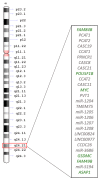The Complex Network between MYC Oncogene and microRNAs in Gastric Cancer: An Overview
- PMID: 32150871
- PMCID: PMC7084225
- DOI: 10.3390/ijms21051782
The Complex Network between MYC Oncogene and microRNAs in Gastric Cancer: An Overview
Abstract
Despite the advancements in cancer treatments, gastric cancer is still one of the leading causes of death worldwide. In this context, it is of great interest to discover new and more effective ways of treating this disease. Accumulated evidences have demonstrated the amplification of 8q24.21 region in gastric tumors. Furthermore, this is the region where the widely known MYC oncogene and different microRNAs are located. MYC deregulation is key in tumorigenesis in various types of tissues, once it is associated with cell proliferation, survival, and drug resistance. microRNAs are a class of noncoding RNAs that negatively regulate the protein translation, and which deregulation is related with gastric cancer development. However, little is understood about the interactions between microRNAs and MYC. Here, we overview the MYC role and its relationship with the microRNAs network in gastric cancer aiming to identify potential targets useful to be used in clinic, not only as biomarkers, but also as molecules for development of promising therapies.
Keywords: 8q24.21; MYC; gastric cancer; microRNA; target therapy.
Conflict of interest statement
The authors declare that they have no conflict of interest.
Figures



Similar articles
-
Downregulation of microRNA-155 accelerates cell growth and invasion by targeting c-myc in human gastric carcinoma cells.Oncol Rep. 2014 Sep;32(3):951-6. doi: 10.3892/or.2014.3288. Epub 2014 Jun 24. Oncol Rep. 2014. PMID: 24969405
-
microRNA-25 Inhibits Cell Apoptosis of Human Gastric Adenocarcinoma Cell Line AGS via Regulating CCNE1 and MYC.Med Sci Monit. 2016 Apr 27;22:1415-20. doi: 10.12659/msm.896118. Med Sci Monit. 2016. PMID: 27120728 Free PMC article.
-
miR-494 acts as an anti-oncogene in gastric carcinoma by targeting c-myc.J Gastroenterol Hepatol. 2014;29(7):1427-34. doi: 10.1111/jgh.12558. J Gastroenterol Hepatol. 2014. PMID: 24612089
-
Intricate crosstalk between MYC and non-coding RNAs regulates hallmarks of cancer.Mol Oncol. 2019 Jan;13(1):26-45. doi: 10.1002/1878-0261.12409. Epub 2018 Dec 5. Mol Oncol. 2019. PMID: 30451365 Free PMC article. Review.
-
N-myc and noncoding RNAs in neuroblastoma.Mol Cancer Res. 2012 Oct;10(10):1243-53. doi: 10.1158/1541-7786.MCR-12-0244. Epub 2012 Aug 30. Mol Cancer Res. 2012. PMID: 22936790 Review.
Cited by
-
SLC39A10 promotes malignant phenotypes of gastric cancer cells by activating the CK2-mediated MAPK/ERK and PI3K/AKT pathways.Exp Mol Med. 2023 Aug;55(8):1757-1769. doi: 10.1038/s12276-023-01062-5. Epub 2023 Aug 1. Exp Mol Med. 2023. PMID: 37524874 Free PMC article.
-
The Silkworm Carboxypeptidase Inhibitor Prevents Gastric Cancer Cells' Proliferation through the EGF/EGFR Signaling Pathway.Int J Mol Sci. 2023 Jan 5;24(2):1078. doi: 10.3390/ijms24021078. Int J Mol Sci. 2023. PMID: 36674593 Free PMC article.
-
microRNA-378a-3p regulates the progression of hepatocellular carcinoma by regulating PD-L1 and STAT3.Bioengineered. 2022 Mar;13(3):4730-4743. doi: 10.1080/21655979.2022.2031408. Bioengineered. 2022. PMID: 35184646 Free PMC article.
-
ZFP1 is a biomarker related to poor prognosis and immunity in gastric cancer.Sci Rep. 2024 Sep 11;14(1):21233. doi: 10.1038/s41598-024-72387-y. Sci Rep. 2024. PMID: 39261568 Free PMC article.
-
MYC and NCAPG2 as molecular targets of colorectal cancer and gastric cancer in nursing.Medicine (Baltimore). 2024 May 3;103(18):e38029. doi: 10.1097/MD.0000000000038029. Medicine (Baltimore). 2024. PMID: 38701261 Free PMC article.
References
Publication types
MeSH terms
Substances
Grants and funding
- 201567/2009-1/Coordenação de Aperfeiçoamento de Pessoal de Nível Superior
- 303871/2014-8/Conselho Nacional de Desenvolvimento Científico e Tecnológico
- 2016/25562-0/Fundação de Amparo à Pesquisa do Estado de São Paulo
- 2012/14768-5/Fundação de Amparo à Pesquisa do Estado de São Paulo
- 2016/19953-6/Fundação de Amparo à Pesquisa do Estado de São Paulo
LinkOut - more resources
Full Text Sources
Medical

